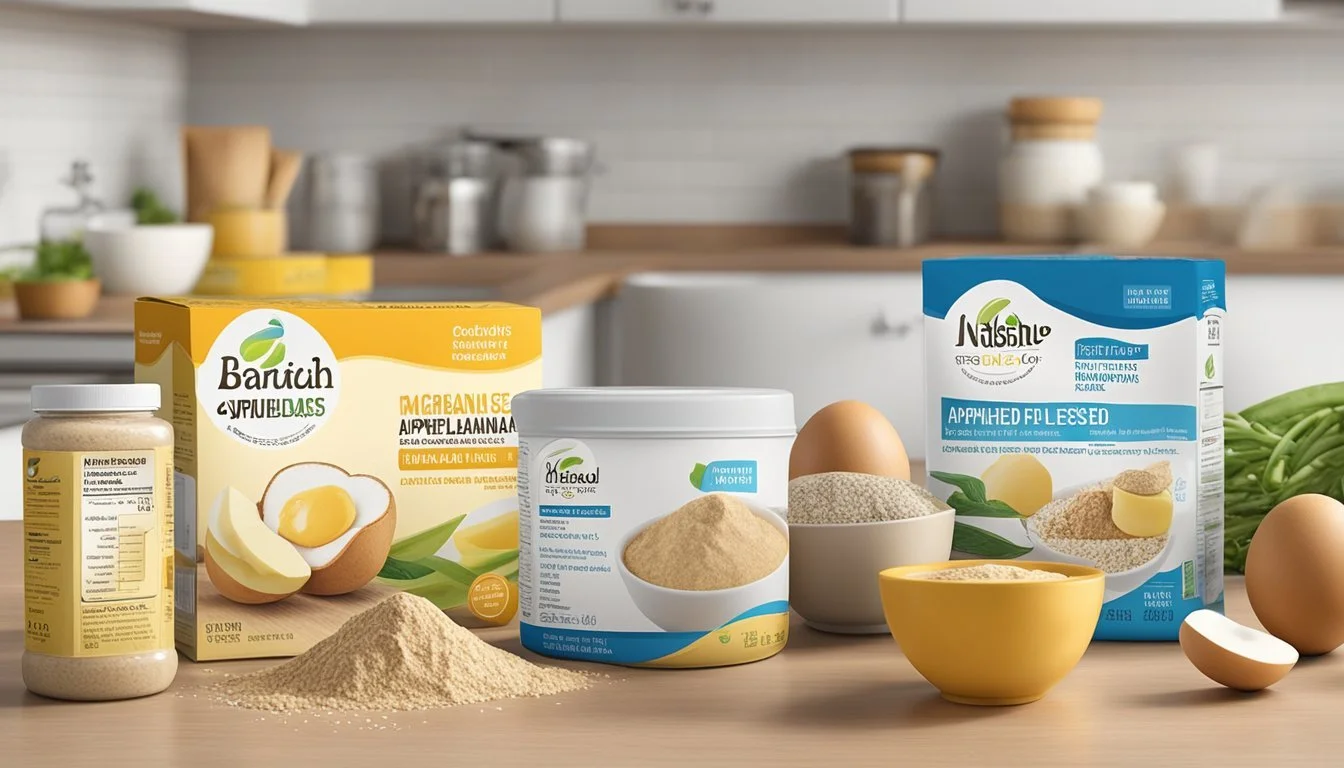Egg Substitutes
Top Choices for Allergy-Friendly Baking
Egg substitutes are a pivotal component in the culinary world for those who choose not to consume eggs, whether due to allergies, dietary preferences, or vegan lifestyle choices. These alternatives are designed to mimic the functional properties of eggs in various recipes, mainly in baking. They serve to bind ingredients, leaven batters, add moisture, or contribute to the richness of the dish. The market offers a diverse range of substitutes, ensuring that nearly every function of the egg can be replicated without compromising on taste or texture.
Understanding the role of eggs in cooking is essential when selecting an appropriate substitute. Eggs serve multiple purposes; as a binder, they hold together ingredients like flour and sugar in cakes and cookies. As a leavening agent, eggs give lift to soufflés and meringues. They also add moisture to batters and can enhance the flavor profile of baked goods. When choosing an egg substitute, one must consider what the egg's purpose is in the recipe to find a suitable alternative that performs a similar function.
The variety of egg substitutes spans from natural products like applesauce, mashed bananas, and tofu, to commercial preparations like flaxseed meal, aquafaba, and various starch-based replacers. Each has its unique properties that can affect the outcome of the recipe. Applesauce provides moisture for cakes, while flaxseed meal, when mixed with water, creates a gelatinous mixture that can bind ingredients effectively. Aquafaba, the liquid from canned chickpeas, can be whipped into a foam resembling egg whites, perfect for creating vegan meringues. Choosing the correct egg substitute can ensure those with allergies or dietary restrictions can still enjoy a vast array of dishes traditionally made with eggs.
Understanding Egg Substitutes
Egg substitutes offer a way to replace the multifunctional role of eggs in recipes for those who avoid them due to allergies, dietary preferences, or health considerations. They provide alternatives in terms of protein, texture, moisture, and flavor.
Role of Eggs in Baking and Cooking
Eggs play a pivotal role in both baking and cooking, serving as binders, leavening agents, and sources of moisture and fat. They contribute to the structure and color of baked goods, and their protein content is crucial for providing texture and firmness.
Reasons for Using Egg Substitutes
Individuals may opt for egg substitutes due to health-related issues such as egg allergies or dietary choices like a vegan diet. Egg substitutes can mimic the characteristics of eggs, providing the necessary fat, structure, and moisture without including any egg components.
Types of Egg Substitutes
There are several types of egg substitutes suitable for various culinary applications:
Plant-based mixtures: These include combinations like 1 tablespoon of chia seeds with 3 tablespoons of water or 1 tablespoon of ground flaxseed with 3 tablespoons of water. Once mixed and allowed to rest, they create a gelatinous consistency that can emulate the binding quality of eggs.
Starches: Starches such as arrowroot, cornstarch, and potato starch can be used. Typically, 2 tablespoons of starch mixed with 3 tablespoons of water can replace one egg.
Tofu: Silken tofu can provide moisture and protein when blended into a smooth consistency. Approximately 1/4 cup of puréed tofu equates to one egg.
Commercial egg replacers: These products often contain leavening agents and gums, designed to mimic the properties of eggs in baking.
Dairy substitutes: For those not following a vegan diet, dairy products like yogurt or buttermilk can be considered, with a 1/4 cup of yogurt being equivalent to one egg for providing moisture.
Natural Egg Substitutes
Natural egg substitutes provide a variety of alternatives for different culinary needs, such as binding, leavening, or adding moisture. These substitutes are particularly useful for those with egg allergies, dietary restrictions, or vegan lifestyles.
Fruit-Based Substitutes
Applesauce: Unsweetened applesauce can replace eggs in baking to add moisture without altering flavor. Use ¼ cup of applesauce to substitute for one egg.
Mashed Banana: Ripe bananas can be mashed and used for their binding properties in recipes. Typically, half a mashed banana is equivalent to one egg.
Pumpkin Puree: This substitute offers a nutritious boost and works well in autumnal or spiced baked goods. A quarter cup can replace one egg.
Avocado: Pureed avocado provides healthy fats and creates a soft texture in baked items. Use the same amount as you would banana or pumpkin.
Dairy and Non-Dairy Alternatives
Yogurt: It can add moisture and a slight tang to baked recipes. Use ¼ cup of yogurt (dairy or non-dairy) per egg.
Buttermilk: It works as a leavening agent when combined with baking soda. For each egg, use ¼ cup of buttermilk.
Seed and Nut-Based Substitutes
Flax Seed: Ground flax seeds mixed with water create a gel-like substance that can be used as a binder. Combine 1 tablespoon of ground flax with 3 tablespoons of water to replace one egg.
Chia Seed: Similar to flax seeds, chia seeds can be used to make a binding gel. Use 1 tablespoon of chia seeds with 3 tablespoons of water.
Nut Butter: Thicker nut butters, such as almond or peanut butter, can help bind ingredients. A few tablespoons can replace an egg, but it’s best in recipes where a nutty flavor is desirable.
Plant-Based Commercial Replacers
Consumers today have a variety of plant-based commercial egg replacers available that cater to nutritional needs and offer convenient alternatives for cooking and baking.
Brands and Varieties
Several brands have established themselves within the market, providing alternatives to traditional eggs. Brands such as Ener-G and Bob's Red Mill offer powders that can be mixed with water to replace eggs in recipes. Ener-G Egg Replacer is a well-known product in this category and can be purchased both in stores and online. Other brands mentioned in search results include The Neat Egg, which combines chia seeds and garbanzo beans, and is preferred for its binding properties in cooking.
Ener-G: A versatile egg replacement suitable for baking or cooking
The Neat Egg: Best for use as a binder in recipes
Bob's Red Mill: Offers gluten-free options and is available widely
Ingredients and Nutritional Profile
Plant-based egg replacers are typically made from natural ingredients that mimic the properties of eggs. The Neat Egg, for example, uses chia seeds which are known for their high omega-3 fatty acid content. When assessing nutrition, these egg substitutes can vary, with some being more protein-rich, and others focusing on incorporating healthy fats like omega-3s. Below is a nutritional comparison for reference:
Brand / Ingredient Protein Content Omega-3 Fatty Acids Ener-G Moderate Not specified Chia Seeds (Neat Egg) Low to moderate High Chickpea Flour High Moderate
It's essential for consumers to check labels for specific nutritional information as it can differ widely between brands and ingredients. Commercial egg replacers not only offer convenience but can also contribute to the nutritional value of a diet, especially when protein and omega-3 fatty acids are considered.
Baking Specific Substitutes
When baking, it's crucial to understand how substitutes behave in recipes to achieve desired textures and flavors. Acknowledging the role that eggs play in baking, this section provides alternatives focused on leavening, binding and thickening, as well as moisture and fat replacement.
Leavening Agents
For cakes and other baked goods that require a rise, one can use various leavening agents aside from eggs. Baking powder and baking soda are chemical leavening agents that release carbon dioxide when moistened and during baking, which causes doughs and batters to rise. Here's how one might use them:
Cakes: Replace each egg with one teaspoon of baking powder mixed with 1 tablespoon of vinegar or lemon juice.
Muffins/Quick Breads: Combine 1 teaspoon baking powder with buttermilk or yogurt in place of an egg for added lift.
Binding and Thickening Agents
Eggs also serve to bind ingredients and thicken mixtures in recipes. In their absence, one can utilize alternatives such as arrowroot powder, cornstarch, and tapioca starch:
Pancakes: Replace eggs with banana or applesauce to provide the necessary binding; 1/4 cup of either substitute can replace one egg.
Baking Thickener: Mix 2 tablespoons of arrowroot powder or cornstarch with 3 tablespoons of water to replace one egg, effective in custards and creams.
Moisture and Fat Replacers
To replicate the moisture and fat provided by eggs in baked goods, options like butter or vegetable oil can be used. These substitutes help maintain a desirable mouthfeel and tenderness in the final product:
Cakes/Muffins: 1/4 cup of unsweetened applesauce or mashed banana can replace each egg, adding moisture without using dairy.
Pancakes/Quick Breads: Using 1/4 cup of vegetable oil or melted butter can serve as a fat substitute per egg, maintaining a rich texture.
Specialty Substitutes and Their Use Cases
Egg substitutes are a cornerstone of specialized diets and culinary practices, offering alternatives for those with allergies, ethical concerns, or health objectives. This section explores various egg substitutes tailored to meet the needs of gluten-free baking, vegan cooking, vegan baking, and high-protein dietary plans.
Gluten-Free Baking
When baking without gluten, substitutes must both bind and add moisture as eggs do.
Silken Tofu: It is an ideal gluten-free substitute that imparts a dense, moist texture, perfect for rich cakes and dense breads. Blend 1/4 cup of silken tofu to replace one egg.
Gelatin: It can be used as a binder in gluten-free baking. Mix 1 tablespoon of unflavored gelatin with 3 tablespoons of warm water to replace one egg.
Vegan Cooking and Baking
Egg substitutes in vegan cooking and baking often have to perform various roles, like binding, leavening, and adding moisture.
Aquafaba: The liquid from canned chickpeas mimics egg whites' properties. Use 3 tablespoons of aquafaba to substitute for one egg white, suitable for meringues and mousses.
Flax or Chia Seeds: These seeds form a gel when mixed with water, acting as a binder. Mix 1 tablespoon of ground flax or chia seeds with 2.5 tablespoons of water to replace one egg.
High-Protein Diet Considerations
For those focusing on a high-protein diet, choosing an egg substitute that also contributes to their protein intake is beneficial.
Firm Tofu: It's a substantial egg alternative for scrambles and quiches due to its high protein content and texture. Mash and season with spices such as turmeric to mimic scrambled eggs.
Black Salt (Kala Namak): Although not a protein source, it’s often used in tofu scrambles for its eggy flavor, complementing the high-protein context of a dish.
Creative Cooking with Egg Substitutes
Egg substitutes in cooking offer versatility to those with allergies, dietary restrictions, or simply a desire for experimentation in the kitchen. They can maintain or enhance flavor, texture, and nutritional content across various meal categories.
Savory Dishes
For savory dishes like omelets, where eggs are the star, silken tofu is a prime choice due to its similar texture and protein content. It can be blended with seasonings and turmeric for color, then cooked in a pan to mimic an egg-based omelet. Another option is a chickpea flour batter, mixed with water and spices, which provides a robust, nutty flavor alongside essential nutrients.
Desserts and Sweets
Desserts and baked goods often require eggs for binding and leavening, yet alternatives like flaxseeds or chia seeds mixed with water create a gel-like substance (also known as flax or chia eggs) that can effectively replace eggs in recipes such as brownies or quick breads. Bakers can also use fruit purees:
For 1 egg:
Unsweetened applesauce: 1/4 cup (excellent for muffins)
Mashed banana: 1/4 cup (adds moisture and a light banana flavor)
Fruit purees are especially suitable for sweet recipes, aiding in moisture retention while adding natural sweetness.
Breakfast Options
In breakfast dishes, using alternatives like sweetened or unsweetened applesauce helps create a subtle sweetness and tender texture in pancakes or waffles. Aquafaba, the liquid from a can of chickpeas, can be whipped into a foam—a perfect vegan substitute for eggs in lighter, airy preparations—while ensuring recipes stay true to their original fluffiness.
Techniques and Tips
When using egg substitutes in cooking and baking, one should ensure that the texture, flavor, and structural integrity of the recipe remain intact. Proper techniques in mixing and adjusting recipes can maintain the desired outcome.
Mixing and Combining Substitutes
Technique: When substituting eggs, one must mix the replacement thoroughly to achieve the correct consistency. For example, a flax or chia seed egg requires combining 1 tablespoon of ground seeds with 3 tablespoons of water until a gelatinous mixture forms. This substitute can bind ingredients effectively in recipes.
Combining: In some cases, combining two substitutes can provide a better result. For instance:
For binding and moisture: Half mashed banana and half applesauce
For lift and aeration: Baking soda mixed with vinegar
Note: Stir the substitutes gently into the dry ingredients to avoid overmixing, which could impact the texture of baked goods.
Adjusting Recipes for Substitutes
Quantity: Not all substitutes equate one-to-one with eggs. A typical replacement amount might be 1/4 cup of unsweetened applesauce or mashed banana for one egg.
Sugar and Flour Adjustments: When a substitute adds sweetness, like banana, one might need to reduce the sugar in the recipe. Similarly, substitutes that are denser than eggs might necessitate altering the amount of flour to achieve the desired consistency.
Add-ins: Tweaking the ratios of other ingredients can also help. For a recipe that needs more lift, one might consider adding an extra 1/2 teaspoon of baking powder.
Preserving Texture and Flavor
Texture: Substitutes can affect the texture of the final product. For baked goods that need to rise, like cakes, carbon dioxide-producing substitutes, such as baking soda and vinegar, are recommended. However, for denser meals like brownies, mash or puree form egg replacements could be ideal.
Flavor: Substitutes can also carry their flavor profile. When using flavorful substitutes like banana, one must consider how it will blend with the other ingredients in the meal.
Emulsification: Some substitutes, such as silken tofu blended until smooth, can emulsify ingredients effectively, similar to eggs, often without significantly altering the flavor or appearance.
By applying these techniques and adjustments, one can create successful substitutions in various recipes, preserving the desired attributes of the meal while accommodating dietary restrictions or ingredient availability.
Health and Nutrition Considerations
When considering egg substitutes, it is crucial to address potential allergies, dietary restrictions, and the balance of macronutrients. These factors play integral roles in nutrition and should align with personal health objectives.
Allergy Information
Individuals with an egg allergy react to proteins found in either egg whites, egg yolks, or both. For those with allergies, using egg substitutes can prevent adverse reactions while still enjoying a variety of dishes. Aquafaba, the liquid from canned chickpeas, is a popular alternative that mimics the properties of egg whites, particularly in recipes requiring aeration such as meringues.
Dietary Restrictions and Preferences
For those with dairy allergies or who follow a vegan lifestyle, avoiding animal products, including eggs, is a priority. Substitutes like tofu provide a texture akin to scrambled eggs and are a staple in plant-based diets. Just Egg, made from mung beans, is a vegan substitute trying to match the nutritional content of eggs without using animal products.
Balancing Macronutrients
Eggs offer a valuable source of protein, fats, and omega-3 fatty acids, contributing to a balanced diet. Substitutes should ideally provide a similar nutritional profile. For instance, tofu is a protein-rich option but typically lacks the fat content of an egg, while commercial egg substitutes might be lower in protein but add fat to mimic the egg's nutritional value. It's important to read labels to ensure that the macronutrients align with dietary goals.






